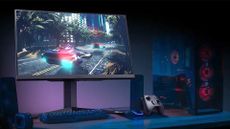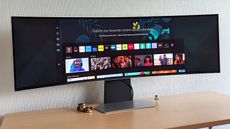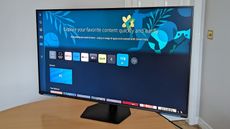Gaming monitors are making huge strides thanks to a bevvy of new technologies, including higher refresh rates, adaptive V-Sync (VRR), and HDR support. These new features however can be price, and depending on just what type of monitor you're after will run you quite a bit up front.
So when BenQ hit the market with their Mobiuz monitors, it was a relief to see that such features could make it into a more "budget-friendly" price range. I say budget-friendly in quotes as this term is subjective, but considering the competition and price points out there, the BenQ Mobiuz EX2710Q is down there with the more affordable options.
But just how does the BenQ Mobiuz EX2710Q monitor stack up against the competition? Take a look at our full review of this impressive gaming monitor and you'll find out.
BENQ MOBIUZ EX2710Q REVIEW: PRICE & AVAILABILITY
The Benq Mobiuz EX2710Q is available now for $349.99. A 32-inch version (the Mobiuz EX3210R) is also available for $534.99.
BENQ MOBIUZ EX2710Q REVIEW: DESIGN & SETUP
The EX2710Q has a simple, clean design with a red and black color scheme. It favors black, but there are touches of red on the stand and around the screen. The 27-inch QHD 2560 by 1440 pixel screen has a very thin bezel that would work well for multi-screen setups and a panel at the bottom that covers the speakers. The only control on the front of the display is a single button that enables the HDRi feature and a small LED light below that shows the power status.
The controls for this display are on the back, in the form of two buttons and a joystick control that are accessed by reaching around the right edge. The bottom button controls the power, while the top provides quick access to the input switch. The two buttons are slightly raised with different textures so you can find them by touch. Pressing the joystick control in the middle opens the main menu, where all the main features are controlled.
This monitor has a decent selection of inputs: two HDMI 2.0 ports, one DisplayPort 1.4, and a USB 3.1 Type B input. Two USB 3.1 Type-A ports connect devices like keyboards, mice, etc. In addition, a 3.5-mm audio output provides for headphones. There are no USB-C, Thunderbolt, or DVI inputs.
That means that, while you will be able to connect devices like game consoles, modern PCs, and most laptops with the included cables, you will need adapters or additional cables for ultraportable laptops and Macs that don’t have HDMI or DisplayPort outputs.
The cables all plug into the back of the monitor, passing through the stand's upright for tidy cable routing. The inverse V design of the stand base means it won’t take up too much space on your desk, and the display can be lifted up to about 5 inches off the desk, as well as tilted up and down by about 15 degrees and left and right by about 20 degrees. You can’ rotate the monitor to landscape mode.
BENQ MOBIUZ EX2710Q REVIEW: SPECS & PICTURE
The Mobiuz EX2710Q has impressive features, including 165Hz refresh rate, AMD Freesync support, HDR10, and Benq’s HDRi mode. What all that word salad boils down to is the experience of using it: does it create a compelling and immersive gaming experience? Does it make your games look and sound better? The answer is pretty much yes.
Playing Doom Eternal on this monitor was an impressively immersive experience. With HDR turned on and the maximum resolution of 2560 by 1440 pixels, the explosions and blood splatters looked great, with vivid bright color, but with plenty of shadow detail so I could see what was lurking in those dark corners. These lacked some of the black and ominous looks you get from the extra dynamic range of OLED monitors; they were more foggy and grey than dark and foreboding.
The 165Hz refresh rate also helped the immersive feel: the motion was very smooth, and I could jump and leap around in Doom Ethernal without the image turning into a fuzzy mess. I’ve tested a few high frame rate monitors, but this had an exceptionally smooth look and felt almost as good as the 240Hz displays I’ve tested.
The screen is not as bright as some we have tested: I measured it in HDR and HDRi mode at a maximum of about 250 Candelas per square meter (Cd/m2), which is on the low side. That’s presumably part of the trade-off involved in supporting HDR, but it does mean that the monitor won’t look as nice in a well-lit room as its brighter cousins.
The sound from the small built-in speakers was also impressive, with deep, rumbly bass and sharp, clear, high-pitched noises like pings and bullet splats. There was also a good sense of space: I could pick out which direction the demons were coming from, which is rare with built-in speakers. They are not very loud, though: if you want explosions that make your teeth rattle, you’ll need more than the 5 Watts that this 2.1-channel sound system can manage.
High Dynamic Range (HDR) videos also looked great, with decent contrast and bright, clear color. The monitor supports HDR10, so it will work with HDR content from Netflix, Disney+, and other sources.
The Mobiuz EX2710Q is AMD Freesync Premium certified but not NVidia GSync certified. However, it should work with NVidia GPU-based GSync graphics cards because it supports the VESA AdaptiveSync standard, so that lack of certification doesn’t matter. I had no issues using an NVidia graphics card to drive this monitor at 165Hz, and I saw no problems between the two.
BenQ also offers a mode called HDRi, accessed by pressing the button on the front of the display. This tries to give existing content an HDR look, even if it is not HDR content. It is… interesting, but it looks like brightness and color saturation are being boosted a bit. It feels unnecessary with more games and content sources supporting HDR, which looks much better.
In addition, the EX2710Q offers modes that reduce blue light to protect your eyes, and an ePaper mode that reduces the contrast and color weakness modes, which help those with color blindness.
BENQ MOBIUZ EX2710Q REVIEW: VERDICT
There are plenty of bigger, brighter, and more colorful monitors, but the Benq Mobiuz EX2710Q hits the sweet spot of balancing features, performance, and price. HDR content and games look great on this 27-inch monitor, and it is cheap enough that you can spend more money on a fancy graphics card to drive it. It’s a great pick for the serious gamer who wants the smooth motion of high frame rate gaming and HDR, but without breaking the bank.
BENQ MOBIUZ EX2710Q REVIEW: ALSO CONSIDER
There are many great gaming monitors out there, with the Viewsonic Elite XG270QG being one of our top picks. This is the same size as the Benq Mobiuz, has the same 165Hz refresh rate, and has the same resolution. It also costs about the same but lacks HDR support, which might be a dealbreaker for those looking for immersive, full-blood spatter gaming.
The Monoprice Dark Matter 27-inch ups the refresh rate to 240Hz, but drops the price to $300. But again, there is no HDR support, and the difference between 240Hz and 165Hz gaming is less than you might think. I’d go with the Benq unless you need to keep the cost down.












